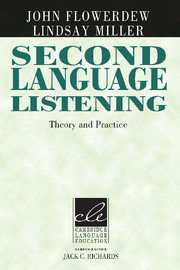Book contents
- Frontmatter
- Contents
- Series editor's preface
- Preface
- Acknowledgments
- Part I HISTORICAL BACKGROUND
- 1 Approaches to Language Teaching and the Role of Listening
- 2 Models of Listening
- 3 Types of Meaning for Listening
- 4 The Nature of Spoken Language
- 5 Learning Styles and Listening Strategies
- Part II A PEDAGOGICAL MODEL AND ITS APPLICATION
- Part III KEY ISSUES IN TEACHING AND TESTING
- Appendix: Concluding Questions for Reflection
- References
- Index
3 - Types of Meaning for Listening
Published online by Cambridge University Press: 04 February 2010
- Frontmatter
- Contents
- Series editor's preface
- Preface
- Acknowledgments
- Part I HISTORICAL BACKGROUND
- 1 Approaches to Language Teaching and the Role of Listening
- 2 Models of Listening
- 3 Types of Meaning for Listening
- 4 The Nature of Spoken Language
- 5 Learning Styles and Listening Strategies
- Part II A PEDAGOGICAL MODEL AND ITS APPLICATION
- Part III KEY ISSUES IN TEACHING AND TESTING
- Appendix: Concluding Questions for Reflection
- References
- Index
Summary
Introduction
In this chapter, we consider the different types of meaning a model of listening must account for. As listening is a cognitive activity and not susceptible to direct observation, it is very difficult to study and describe. However, as an essential component of communicative competence, it is necessary that we have an idea of what is involved in listening in any attempt to develop a principled approach to language pedagogy. In this chapter, we review the various types of meaning that we hypothesize must form a part of any such model.
Types of Meaning
In order to comprehend a spoken message, four main types of knowledge may be drawn on: phonological – the sound system; syntactic – how words are put together; semantic – word and propositional knowledge; and pragmatic – the meaning of utterances in particular situations. We review these types of meaning in turn, suggesting what role they might play in the overall listening process. In addition, we consider an additional type of meaning, kinesic knowledge, which is conveyed by the facial and bodily movement of the speaker. This type of meaning, of course, is present only in those types of listening where the speaker is visible.
Phonological Knowledge
PHONEMES
Phonological knowledge is needed in listening comprehension to be able to segment the message into its component sounds. We will start with the phonemes, the smallest unit of sound that can distinguish two words.
- Type
- Chapter
- Information
- Second Language ListeningTheory and Practice, pp. 30 - 46Publisher: Cambridge University PressPrint publication year: 2005



